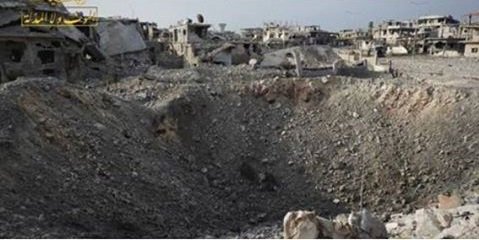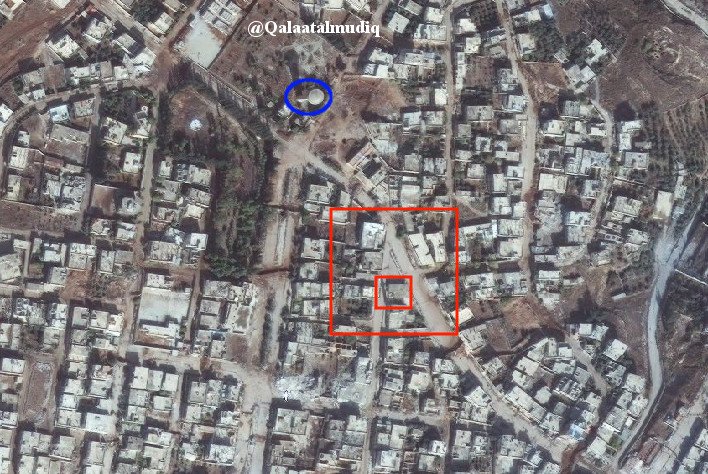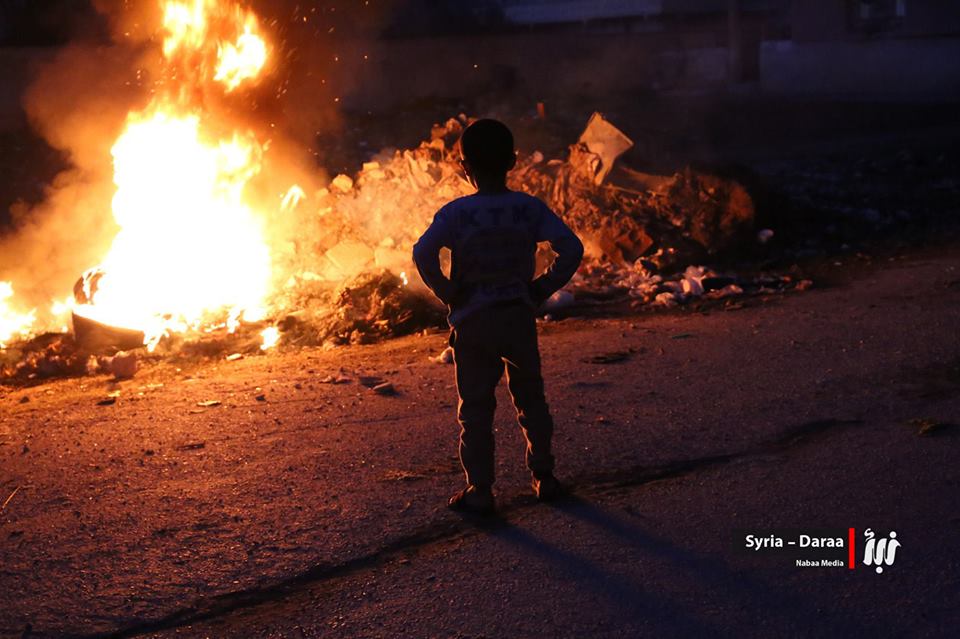
'After nearly five years of bitter fighting, bombardment, and siege, the Bashar al-Assad regime, Iran, and Russia finally broke Aleppo on December 22, 2016, defeating the opposition and displacing much of the local population. This represented a critical turning point in the Syrian civil war and shifted the balance of power between the United States, its local allies, and its adversaries in Syria. The siege of Aleppo brought the horrors of the twentieth century’s wars to the twenty-first century. Hospitals were bombed, not once or twice, but repeatedly; cluster bombs and incendiaries fell on residential areas; chemical weapons were used. Siege, hunger, and indiscriminate strikes brought suffering to women, children, the disabled, and the very old. This report details the tactics and strategy that the regime coalition used to break Aleppo.
Beyond Aleppo’s implications for Syria, it bears highlighting what it means for the United States. First, despite being party to the ceasefires negotiated by the United States and Russia, the Syrian regime used them to prepare offensives or freeze some frontlines in order to concentrate on others. Instead of being punished for this, the regime was actually rewarded with more ceasefires, which it then exploited in the same fashion. These breaches weakened the United States’ moderate opposition partners and undermined the confidence of US allies in the region. Breaking Aleppo also involved a pernicious misinformation campaign–nothing less than a war on objective facts by the regime, Russian officials, and media. This was aimed less at convincing than at confusing and disorienting rivals, sapping confidence, sowing disunity, and making truth entirely subjective, such that one party’s lie became just as good as another’s fact. Finally, the regime’s war in Aleppo showed that Assad was ineffective against the Islamic State of Iraq and al-Sham (ISIS) and other extremists– suggesting that the Syrian regime would be a poor if not harmful partner for the United States. He was unable to rein in sectarian Shia militia even after Aleppo fell, and his regime more closely resembles an unwieldy coalition of sectarian and organized criminal elements. He and his allies deliberately conflated extremist groups with Syrians holding even legitimate grievances against the government, and rather than use ceasefires to deploy forces against extremists, the regime coalition chose to attack mainstream rebels, in some cases actually losing territory to ISIS as a result.
While the reduction in violence during each ceasefire temporarily alleviated suffering across the country, in most cases the ceasefires were used by the government and its allies to gain ground or position themselves for future operations. Tracking the ceasefires in Aleppo throughout 2016 provides useful context and an insight into the way ceasefires played into the warring parties’ broader strategic aims. The US and Russia reached agreement on February 22, 2016, for a nationwide cessation of hostilities to begin on February 27. The agreement did not apply to either ISIS or the Nusra Front, but applied to the opposition and government alike. The agreement also stipulated that there must be unimpeded humanitarian aid access to all areas. In Aleppo, government strikes continued throughout the period of the ceasefire. Ostensibly aimed at the Nusra Front, these in fact struck a wide range of targets, including civilians and opposition groups, in what has been termed a “relentless” series of violations. By late April, the government was striking the opposition-held half of the city with heavy bombing, including on hospitals. For the religious observance of Eid, a “regime of calm” was “implemented across all territory of the Syrian Arab Republic for a period of 72 hours from 1 a.m. on July 6 until 2400 on July 8, 2016.” The government and its supporters (Hezbollah, Russia, and Iranian militias) used the three-day window to attack the approach road to Aleppo and work toward bringing about the siege of the city. On the morning of July 6, within hours of the beginning of the ceasefire, there were reports of attacks on the area around the Castello Road. Throughout the ceasefire, fierce fighting was reported in and around the same area, the north of the city.
According to the Syrian Network for Human Rights (SNHR), Aleppo was hit by 4,045 barrel bombs in 2016, with 225 falling in December alone. A record of attacks compiled by the first responder organization Syrian Civil Defence, known as the “White Helmets,” covering the period from September 19, 2016 until the evacuation in mid December showed 823 distinct reported incidents, ranging from cluster-munition attacks to barrel bombs.
As many as 172 verified attacks on medical facilities and personnel were reported across Syria between June and December 2016.101 According to figures from the Syrian American Medical Society (SAMS), seventy-three of those (42 percent) occurred in the city of Aleppo. The attacks were so frequent, and some key hospitals were struck so many times, that the incidents appear to constitute a systematic attempt to destroy the city’s medical support. The evidence that many hospitals were hit, and that individual hospitals were hit repeatedly, is extremely strong. Nonetheless, throughout the conflict, the response from the Syrian and Russian governments was to deny any and all accusations of deliberately targeting hospitals. Lacking direct documentary or eyewitness evidence of orders given by the government and its allies to target hospitals, those denials are difficult to disprove. However, several strands of circumstantial evidence point toward hospital strikes as a deliberate policy. The first circumstantial thread is the sheer volume of strikes on medical facilities recorded during the conflict: over 400 across Syria, according to Physicians for Human Rights; over 70 in Aleppo in the second half of 2016, according to SAMS. It is very unlikely that such a high rate of strikes on facilities covered under the Geneva Convention was accidental. Second is the Assad government’s intimate knowledge of the terrain. It has ruled the country for decades; most, if not all, of the hospitals destroyed were built under its aegis. It would therefore be illogical to argue that the government and its allies did not know where the hospitals were. They did know; but somehow, they failed to protect them, not once or twice, but hundreds of times. At best, this is a systemic failure of the duty to protect medical facilities; at worst, it suggests a deliberate policy of targeting hospitals. A third indicator is the repeated confiscation by pro-government forces of medical supplies from humanitarian aid convoys to opposition controlled areas across Syria. While trauma and surgical equipment was most frequently removed, antibiotics, anesthetic and antibacterial medicines, obstetric kits for midwives, burn kits, and other medicines were all extracted. In one convoy to besieged al-Waer in 2016, 5.3 tons of medical aid was removed from a convoy, allowing only 440 kg to get through. This apparent attempt to deprive doctors and hospitals in areas under opposition control of medicines and supplies suggests a consistent strategy, implemented whenever and however possible. The final indicator is the strategic context of the strikes, and their application in the broader pattern of siege warfare. The bombing of Darayya’s last hospital on August 18, 2016, precipitated the agreement of the community to accept an evacuation deal. Darayya had endured four years of siege; the loss of the hospital was a decisive factor in the civilian population’s decision to vacate the area. Taken together, this evidence strongly suggests that the Assad government and its allies targeted hospitals deliberately, as part of a strategy intended to break the will and infrastructure of the resistance.
Between June 5 and August 10, 2016, HRW reported that incendiary weapons were used at least eighteen times on targets in the opposition held areas of Aleppo and Idlib provinces; no fewer than nine incidents above opposition-held east Aleppo were reported in September. In the words of HRW’s report, “For at least a few weeks in mid-2016, incendiary weapons were used almost every day in attacks on opposition-held areas.
According to the Cluster Munition Coalition, Syrian forces used at least 249 cluster munitions in ten out of Syria’s fourteen governorates between July 2012 and July 2014. This number only reflects incidents in which remnants of cluster munitions were recorded and identified, so the actual figure may be higher. According to the same source, 2,221 people in Syria were killed or wounded by cluster munitions between 2012 and the end of 2015.174 Witnesses to the Syrian conflict have documented the use of a wide range of cluster munitions. Types identified include unguided air-dropped munitions such as RBK-500 series cluster bombs, surface-to-surface rockets, including the 122mm Sakr rocket,175 and 9M55K 300mm rockets launched by the modern Russian BM-30 multiple rocket launcher.When Russia began its air campaign in September 2015, previously undocumented cluster munitions began to be recorded at attack sites, in particular the AO-2.5RTM, ShOAB-0.5M,177 PTAB-1M,178 and SPBE submunitions used with RBK-500 cluster bomb casings. Following reports by Human Rights Watch, Amnesty International, and other organizations about the use of cluster munitions in Syria, the Russian Ministry of Defense denied any and all use of cluster munitions by Russian forces, stating “Russian aviation does not use them,” and going as far to claim were “no such munitions at the Russian air base in Syria.” These denials were exposed as false when photographs and video from Russian media, including Kremlin broadcasters Sputnik and RT, as well as the MoD’s own photographs, showed cluster munitions at the Russian air base in Syria, and even loaded onto Russian aircraft. As detailed above, RT was later caught editing footage posted on their YouTube channel, removing footage of cluster munitions mounted on Russian jets at their airbase in Syria.
Since the Sarin attacks in Damascus on August 21, 2013, there have been dozens of reports of chemical weapon attacks across Syria using chlorine, sarin, mustard gas, and other agents. In August 2016, the third report of the Organization for the Prohibition of Chemical Weapons United Nations (OPCW/UN) Joint Investigative Mechanism concluded that Syrian government forces had used chlorine gas in two attacks, and had probably committed several more, between April 2014 and September 2015, including in cases where evidence had been removed.
Even as the OPCW-UN were publishing their report in August 2016, fresh allegations of chemical weapons attacks were emerging in Syria, including in opposition-held east Aleppo. At the start of August two attacks were reported in the city, one on August 2, and a second on August 10. In the August 10 attack, victims reported they had been hit by a barrel bomb containing chlorine gas dropped from a helicopter, a mode of attack consistent with other reports of chlorine gas use by Syrian government forces. Over seventy individuals were reported injured in the attack, including approximately thirty young children; three deaths were reported, including two children. The UN’s Syria Envoy, Staffan de Mistura said: “There seems to be a lot of evidence that it did take place.” A further attack was reported on September 6, with over 150 victims transferred for treatment in local medical facilities. Multiple witnesses reported the use of helicopters to drop the bomb, as well as the distinctive smell of chlorine at the attack site. Two deaths were reported from the attack, one of them, a thirteen-year-old child. Al-Quds hospital treated many victims of the attack, sharing photographs of victims being treated on its Facebook page: A medical report provided to Bellingcat by doctors at the al-Quds hospital listed the details of the victims:208 seventy-one patients treated as a result of the attack, including sixteen children below the age of five, twenty children between the ages of six and eighteen, and one pregnant woman. The report also stated that the victims were treated for exposure to chlorine. The identification of chlorine as the agent is consistent with other reports, including statements recorded by various organizations and individuals working in the area. In a video published online by the White Helmets, a rescuer described the smell of chlorine at the attack site; American proopposition journalist Bilal Abdul Kareem produced a video from the attack site stating “The smell of chlorine is very strong here”; and in a video from the SMART News Agency filmed at the entrance to the al-Quds hospital, one man said that he found one of the victims and they smelt of chlorine.
In mid-January 2017, the Syrian Network for Human Rights reported that it had documented the arrest or enforced disappearance of no fewer than 2,367 people from Aleppo governorate, including at least 89 women and 64 children, from July 1 to December 31, 2016. A correspondent for Aleppo Today, Ahmad Mustafa, and his father and two brothers were reportedly detained after they escaped east Aleppo; a younger brother was reportedly tortured before being released. Abdulhadi Kamel, a member of the White Helmets, was captured while fleeing to safety with his family. He was interviewed by pro-Kremlin media outlet ANNA News, which is based in the breakaway Georgian territory of Abkhazia—a region that depends on Kremlin military and financial support for its existence. In the interview, Kamel confessed to having staged his rescues in order to receive financing from Europe, Turkey, and “the Gulf monarchs.” However, the White Helmets have said that the “confession” was made under duress,74 and a follow-up investigation by independent outlet Middle East Eye quoted “local sources” as tracing Kamel to the “Air Force Intelligence security branch in Aleppo, where former prisoners frequently recount abuse by officers.” One former resident of east Aleppo who is known to this report’s authors said that one of his students, whom he named, was arrested on December 9, together with the student’s father. He also named four male members of a family from the al-Mayasser neighborhood as having been arrested. Another source said he knows “ten people who are arrested now and their families can’t meet them—they are in the secret police prisons.” He was not willing to name the detainees who were reportedly arrested, so verification of these vague reports is difficult. Arrests of east Aleppo residents reportedly continued into January. On January 3, in Hidaria neighborhood, the identification documents of residents were collected; many young men were reportedly arrested the following day. Another source known to the authors said, “Two of my relatives were arrested after they decided to stay in their houses when the regime’s militias were advancing.” He also named two other men, and a family group, who were arrested when they went from east to west Aleppo. Accurate information on this issue is sketchy, as relatives are reluctant to provide information, for fear it will place their loved ones in still graver danger; however, the number of reports of arrests is increasing. The Caesar photos, so-called for the code-name of the alleged military defector who smuggled the material out of Syria in August 2013 and showed evidence of the torture and summary execution of thousands of detainees, are a chilling reminder of the fate victims of Syria’s prisons and security services can meet. Executions were reported on three main occasions. In order to reduce confusion, only civilians reported executed are covered here, despite the fact that the summary execution of any captive is considered unlawful conduct under international law. When opposition forces withdrew from the northern suburbs of east Aleppo and government forces came into the area, there were reports of executions. In several cases, photographic evidence was provided by former residents of east Aleppo who are known to this report’s authors. They named one of the victims as Mohammad Abdo Sultan, a mechanic who fixes generators whom they knew personally, and who was executed in the northern neighborhoods of east Aleppo beside an unnamed man, reportedly the owner of a bakery. There are other, less specific, allegations from this time. The UN reported that they had received information regarding eighty-two executions in early December. On January 20, the Office of the High Commissioner for Human Rights (OHCHR) confirmed in a telephone call that they had had “further corroboration of the executions we reported on in December, and of missing people.”
A credible ceasefire in Syria does not require occupying the country, or engaging in nation building. What it does require is the imposition of costs on violators (overwhelmingly the regime, Iran, and its proxies) whether through direct kinetic action, robust support for local allies on the ground, or any other effective measures in the policy toolkit. Breaking Aleppo did not end the war or its serious challenges to US interests. Dark as it is, however, it is also a valuable call to action, a hard lesson in the cost of inaction, and a case study in a new and devastating combination of tactics honed by the United States’ adversaries. Aleppo’s catastrophe must inform a US strategy that is both bolder and wiser than that which allowed it to happen.'








